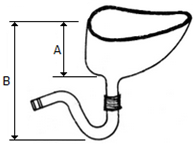This set of Civil Engineering Drawing Multiple Choice Questions & Answers (MCQs) focuses on “Sanitary Works”.
1. __________________ is any work involved in fixing or unfixing any pipe, plumbing fixture or appliance including; any trap, waste or soil pipe, ventilation pipe, or overflow pipe and any pipe that supplies or is intended to supply water.
a) Domestic plumbing
b) Flooring
c) Sanitary plumbing
d) Plastering and putting
View Answer
Explanation: Sanitary plumbing is any work involved in fixing or unfixing any pipe, plumbing fixture or appliance including; any trap, waste or soil pipe, ventilation pipe, or overflow pipe and any pipe that supplies or is intended to supply water.
All sanitary plumbing must comply with the Building Code and, where a building consent is required; the work must be checked by the building inspector from the building control authority in your area (your local council). A code compliance certificate cannot be issued until the work has been signed off by the building inspector.
2. __________ is the highest form of decontamination.
a) Sterilization
b) Sanitation
c) Disinfection
d) Hygiene
View Answer
Explanation: The process of rendering an article safe to handle, by cleaning with or without disinfection or sterilization. Disinfection: The process of killing or removing pathogenic micro-organisms, except for bacterial spores and prions from inanimate objects or skin, to a level which is not harmful to health.
3. Sanitary plumbing includes the installation of appliances such as dishwashers and washing machines; the replacement or repair of taps, ball valves and plugs.
a) True
b) False
View Answer
Explanation: Sanitary plumbing does not includes the installation of appliances such as dishwashers and washing machines; the replacement or repair of taps, ball valves and plugs.
4. The lowest or weakest level of decontamination is sanitation.
a) True
b) False
View Answer
Explanation: The strongest level of decontamination in increasing order is: Sanitation, Antiseptic, Disinfection, Sterilization.
5. The value of ‘B’ of Indian type W.C. shown in the given figure is?

a) 60 cm
b) 45 cm
c) 25 cm
d) 15 cm
View Answer
Explanation: A flush toilet may be colloquially called a lavatory, water closet (abbreviated W.C.), loo, comfort room (abbreviated C.R.), and many other names.
A flush toilet is a toilet that disposes of human excreta (urine and feces) by using water to flush it through a drainpipe to another location for disposal, thus maintaining a separation between humans and their excreta. Flush toilets can be designed for sitting (in which case they are also called “Western” toilets) or for squatting, in the case of squat toilets. The opposite of a flush toilet is a dry, which uses no water for flushing.
6. Anti-siphonage pipe is connected to _____________
a) top of P trap W.C.
b) main soil pipe
c) bottom of P trap W.C.
d) side of water closet
View Answer
Explanation: A vent is open at top and bottom, to facilitate exit of foul gases. It is carried at least one meter higher than the roof level. Rain water pipe: it is a pipe which carries only the rain water. Anti-siphonage pipe: it is pipe which is installed in the house drainage to preserve the water seal of traps.
7. The trap which is provided to disconnect the house drain from the street sewer is called __________
a) interceptor chamber
b) intercepting trap
c) interception manhole
d) interceptor chamber, manhole and trap
View Answer
Explanation: A large sewer that receives flow from a number of trunk sewers and transports the flow to the wastewater treatment plant. These sewers do not connect to homes, buildings or street.
8. The diameter of a domestic sewer pipe laid at gradient 1 in 100 is recommended ________
a) 100 mm
b) 150 mm
c) 210 mm
d) 400 mm
View Answer
Explanation: A sanitary sewer or “foul sewer” is an underground carriage system specifically for transporting sewage from houses and commercial buildings through pipes to treatment facilities or disposal. Sanitary sewers are part of an overall system called a sewage system or sewerage.
Sewage may be treated to control water pollution before discharge to surface waters. Sanitary sewers serving industrial areas also carry industrial wastewater.
Sanfoundry Global Education & Learning Series – Civil Engineering Drawing.
To practice all areas of Civil Engineering Drawing, here is complete set of 1000+ Multiple Choice Questions and Answers.
If you find a mistake in question / option / answer, kindly take a screenshot and email to [email protected]
- Check Civil Engineering Drawing Books
- Apply for Civil Engineering Internship
- Check Civil Engineering Books
- Practice Civil Engineering MCQs
